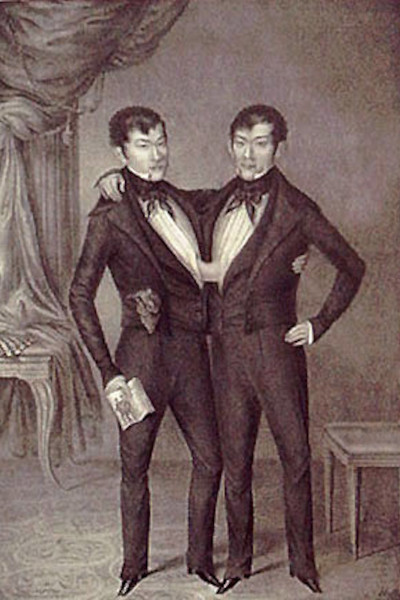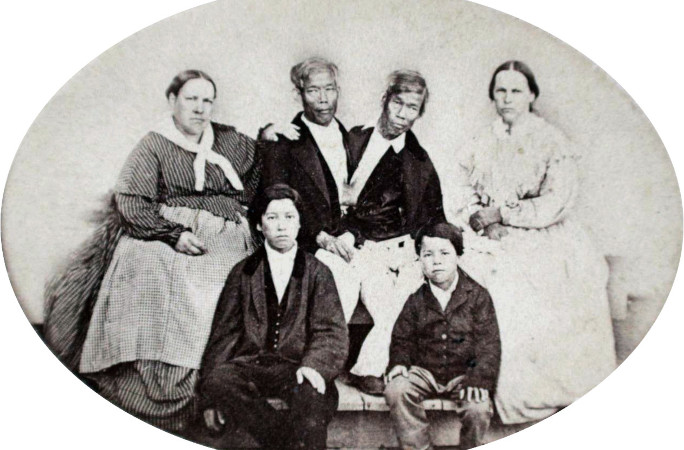Medical miracles and strong connections: the record-breaking history of conjoined twins

At least as far back as 4000 to 2200 BC, when a white marble statue was built in Anatolia depicting two women joined at the hip, we have known about the curious medical phenomenon of conjoined twins.
This five thousand year old artwork was discovered in a Neolithic shrine, and was the first depiction of conjoined twins ever discovered – and despite the rarity of this condition, conjoined twins have attracted attention from scientists and laypeople for centuries.
Medical professionals estimate that conjoined twins occur once in every 50,000 to 60,000 births, and up until the late 20th century, the condition was extremely difficult to survive – both during the pregnancy and during any possible separation surgeries.
To this day, there is still a 60% risk of stillbirth, and the affliction is associated with a higher predominance in the female sex, with a rate of 3 in 1 living conjoined twins being female.
Nevertheless, due to the rarity of the condition and the suspected high number of underreported cases, scientists aren’t completely sure how these twins physically fused in utero and consequently at birth.

Image credit: Herman Klapproth / Wikimedia Commons
“The dominant theory on the origin of conjoined twins suggests that when the single embryo splits later, separation stops before the process is complete, leaving the babies joined,” says the Children’s Hospital Colorado. “Alternatively, another theory holds that two separate embryos fuse in early development. What would cause either scenario remains unknown.”
Still, a number of conjoined twins have survived to adulthood and even found fame because of their condition. In this piece, we delve into the history of some of these conjoined twins, and the medical research that helped make their lives remarkable.
Chang and Eng
Perhaps the most famous pair of conjoined twins were Chang and Eng Bunker – of whom the outmoded term “Siamese Twins” originated.

Image credit: Alfred Hoffy / Wikimedia Commons
Chang and Eng (Thailand) were born on 11 May 1811 at Meklong in Siam, modern-day Thailand, to Chinese parents – hence their nickname as “Siamese Twins”. They were joined by a fleshy bit of cartilage at the chest and shared a liver, a situation which could now be surgically repaired, but back then the concept of separation was inconceivable.
The pair were ‘discovered’ in 1824 by a Scottish businessman named Robert Hunter, who thought the pair were an economic opportunity, and he brought them to America in 1829 when the twins were 17 years old. At first, they toured the US performing physical feats like somersaults, but as they learned English and earned more money and fame, they took control of their act and invited audiences to ask them questions instead in a more formal setting.
The pair resided in North Carolina, and after gaining citizenship they married sisters Adelaide and Sarah Yates and built two homes nearby so they could spend three days a week in each household.
However, their legacy was marred by the fact that they owned a slave plantation and supported the Confederacy during the Civil War, a dark history that we explored further in our Curious Casebook series on Snapchat:
With their wives, the pair fathered 21 children: Chang and Adelaide had 10, while Eng and Sarah had 11, setting a record for the most children born to unseparated twins.
We asked Dr Nancy Segal, our resident twin expert, about these mechanics in 2023 and she explained: “There are all sorts of human variations, and we have to get used to those, and some people might recoil in horror at the idea of identical conjoined twins marrying into their families but it’s a variation on the human being and that’s the way it is.”
She also added: “What’s interesting… is because they were genetically identical, the children from the two different couples were genetic half siblings – because they had genetically identical parents, so they weren’t just cousins, they were genetic half siblings.”

Image credit: Mathew Brady / Wikimedia Commons
Chang and Eng passed away at age 62 on 17 January 1874, after Chang died in his sleep and Eng followed him shortly thereafter. To date, they have over 1,500 descendants who regularly meet up in North Carolina, and the pair even held the record for the oldest conjoined twins ever (male), until it was broken by Ronnie and Donnie Galyon (USA; 1951 - 2020), who lived to be 68.
Ronnie and Donnie
Ronnie and Donnie were born in Dayton, Ohio, on 25 October 1951 and spent their first two years in the hospital until doctors ultimately determined they could not be separated. The twins shared an abdomen and a pelvis, but had their own heart, stomach, liver, lungs and kidneys, as well as their own arms and legs.
In adulthood, the twins lived independently, residing in a home not far from their younger brother Jim and his wife Mary. They shared interests, like watching TV and playing with toy cars, as well as sharing lifestyle habits like cooking and cleaning.
Apparently, the twins also took turns shaving each other’s faces in the morning, and were active in their community – moving around using a custom double wheelchair.
Yet they also shared noticeable differences in personality and temperament, and they’d fight like any other brothers, bickering for days until Jim said Ronnie was usually the first to apologize.
And just like the oldest pair of female conjoined twins, the Galyon brothers were determined to never be separated.
“We were born this way by God and we are happy the way we are,” Donnie once said.
They became the world’s oldest conjoined twins ever on their 63rd birthday after passing the age of Chang and Eng, and reportedly were thrilled to be featured in the Guinness World Records book. Yet the pair sadly passed away due to heart failure on 4 July 2020, aged 68 years 253 days.
Read more about those with inspiring stories in our Human Body section!
Lori and George
One of the rarest forms of conjoined twins are craniopagus twins – when two people are fused at the skull. With just a 5% chance of likelihood, these brave souls are a unique case, yet Guinness World Records was honoured to feature a set of twins with these incredible features.
Lori Lynn and George (b. Dori) Schappell were a pair of craniopagus twins who lived a miraculously long life. Born on 18 September 1961 in Reading, Pennsylvania, USA, these siblings bore the remarkable title of oldest female conjoined twins ever when they passed away at age 62 years 202 days old on 7 April last year.
The pair had partially fused skulls, sharing vital blood vessels and 30% of their brains (the frontal and parietal lobes). Yet despite being connected at the head, they had many different characteristics – Lori was able-bodied, but George had spina bifida and needed Lori to push him in a wheelchair in order to move. George also had a successful career as a country singer, while Lori was a champion ten-pin bowler, who also worked shifts at a hospital laundry gig while George was not touring.
The twins also made history in 2007, when George came out as transgender and began presenting as a man. They became the first same-sex conjoined twins to identify as different genders, with George changing his name from Reba (after his hero Reba McEntire) to George since he disliked the rhyming names given to him and his twin.
They also tried to live as independently as possible, sharing a two-bedroom apartment in Pennsylvania and switching days spent in each room, as well as practising different hobbies and taking separate showers, with one twin standing on the other side of the curtain.
Yet despite their differences, the twins were glad that they were never separated – in a 1997 interview, watchable below, George said: “Would we be separated? Absolutely not. My theory is: why fix what is not broken?”
And together, the pair defied all the odds – living well past the age of 30, when doctors said they would take their final breath. They died at the Hospital of the University of Pennsylvania in 2024 due to undisclosed causes, and were survived by their father, six siblings, several nieces and nephews, and an extended family of friends.
Masha and Dasha
To date, the rarest conjoined twins ever recorded were Masha and Dasha Krivoshlyapova (Russia), who were born in the USSR on 3 January 1950 and died within 17 hours of each other on 17 April 2003.
The pair were dicephalus tetrabrachius dipus twins, meaning they had two heads, four arms and one leg each. They also shared one reproductive system, bladder, and colon, but had separate spines, small intestines, hearts and lungs.

Image credit: Alamy
Author Juliet Butler spent over 12 years chronicling their lives in the book The Less You Know the Sounder You Sleep, exploring their upbringings, characteristics, and tragic history with medical experimentation in the Soviet Union.
She told the Telegraph in 2017 that the twins were astoundingly unaware of their medical diagnoses and early lives, at one point not even knowing the term “conjoined”, yet despite their condition they were still strikingly different people.
“There’s nothing identical about us!” Masha told Juliet. “We’re completely different people. We must have become joined together somehow.”
Three years after their death in 2003, Juliet began writing the biography about their lives, saying that with the novel she intended to personalize Dasha’s wishes for a society that was more tolerant towards people with visible disabilities.
“I hope that in telling her story I can bring that tolerant society a little closer to reality,” she said.
And every time we tell stories about these conjoined twins, we share in Juliet’s belief that with more discussion comes more scientific research and cultural acceptance for those with disabilities – particularly those who make their diverse life Officially Amazing.
Header image: Wikimedia Commons, Alfred Hoffy and Herman Klapproth


